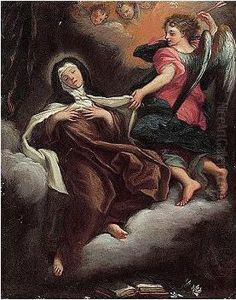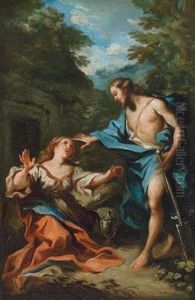Michelangelo Cerruti Paintings
Michelangelo Cerruti was an Italian painter of the late Baroque period, active mainly in Rome and Turin. Born in 1663 in Rome, Cerruti was part of a vibrant artistic scene that was deeply influenced by the legacies of Baroque masters such as Caravaggio and the Carracci family. His works are characterized by their dynamic compositions, vibrant colors, and dramatic use of light and shadow, embodying the theatricality that is typical of the Baroque era.
Cerruti's early training is not well-documented, but it is believed that he was initially influenced by the Roman school of painting. He later moved to Turin, where he became associated with the court of the Savoyard dynasty. In Turin, Cerruti's talents flourished, and he received numerous commissions for religious and decorative works. His style evolved to reflect the grandeur and elegance favored by the Piedmontese nobility, and he played a significant role in the development of the late Baroque artistic landscape in Northern Italy.
Throughout his career, Michelangelo Cerruti worked on various projects including frescoes, altarpieces, and private devotional paintings. One of his notable works includes the frescoes in the Church of San Bernardino in Ivrea. Despite his prolific career, Cerruti's works were somewhat overshadowed by his contemporaries, and as a result, he was not as well-known outside of Italy. Nevertheless, his contributions to the evolution of Baroque painting in Northern Italy remain significant.
Michelangelo Cerruti died in 1749 in Turin. Today, his works can be found in several Italian churches and collections, where they continue to be studied and appreciated for their artistry and historical significance. His legacy is that of a skilled Baroque artist who brought a sense of dynamism and decorative elegance to his canvases, reflecting the complex cultural and artistic currents of his time.

